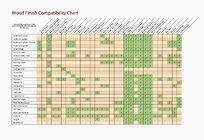Perry-These are very useful questions that I often ask myself too, so I will be watching the responses with you. Frankly, the more I research sanding sealers, the more confused I get by all the differing opinions sometimes, so I rarely break out the Mylands cellulose sanding sealer that gives me the side-eye from the back of my finishes cabinet sometimes...I do know that some great turners recommend a sanding sealer before using an abrasive paste. There are some very helpful finish compatibility charts out there; I've seen it here somewhere, probably on another thread like this one. I expect someone will re-post it directly. If not, Chestnut Products actually sells a poster-sized chart for your shop wall (though I would just try to find a free one to download myself):
Finish Compatibility Chart
I can tell you from my own extensive use of Yorkshire Grit and EEE abrasive pastes that both work beautifully over a bare, well-sanded surface with no sanding sealer involved (so one less step). If I'm doing entry-level spindle work for my craft show table (bottle openers and such), I will usually just sand to 220, then on with the paste. On a bowl I want a fine finish on, I might sand all the way to 600 or 800 and then do the friction polish. Then just take a folded shop towel and "friction polish" off the excess. From there, I have successfully applied TruOil gunstock finish, all of the Tried and True oils, and Doctor's Woodshop Walnut Oil and Wax successfully with zero issues. I'm mostly a hand-rubbed oil finish guy, so I can't speak to your various poly's, lacquers, etc., though I may try that on an inexpensive spindle piece to see how it does.
I do know that some turners use an abrasive paste on top of the finish with great results, I would assume after it has fully cured. I haven't done that (yet), but I bet it would take that shine that next step further. I have usually just gone to the Beall buffs when I want that kind of shine, but like many on here, I am always experimenting, chasing that holy grail of the "perfect finish." I hope this helps. I have often found that sometimes you just have to experiment as you let your experience and instincts tell you what would probably work where.

